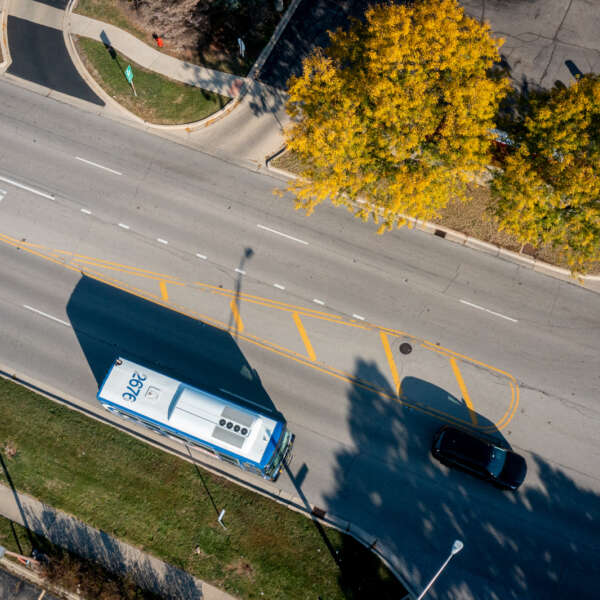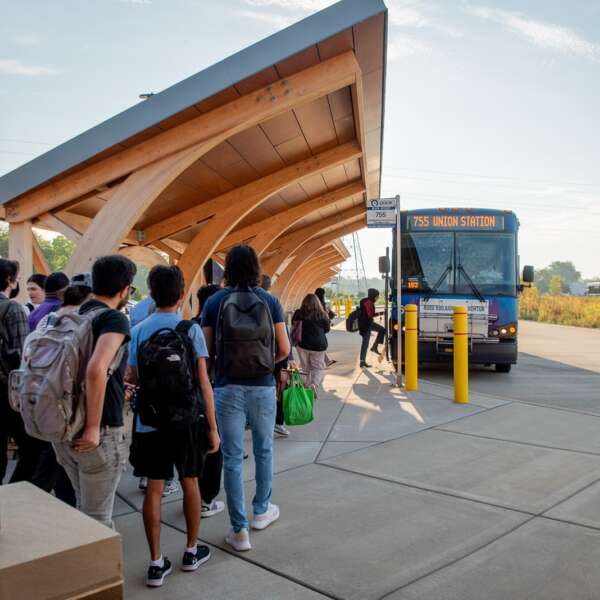Why Illinois legislators must reach a transit funding solution by spring 2025—and what happens if they don’t
October 9, 2024
October 9, 2024

Chicago’s regional transit system is facing a projected operating shortfall of more than $730 million annually—or nearly 20% of the regional operating budget—starting in 2026 because of historic underfunding and lower fare revenues from changing post-pandemic travel patterns. While the RTA, Service Boards, and advocates have been ringing the alarm bell about the fiscal cliff for years, the window for Illinois legislators to act is narrowing.
Transit agencies are required by law to present a balanced budget each year. Currently, federal COVID relief funding is covering the gap between operating expenses and existing revenues and state and local funding. Although the operating budget gap won’t hit until 2026, due to annual funding cycles and federal service planning requirements, a solution must be reached during the spring 2025 legislative session to ensure a smooth transition without service cuts and/or fare increases.
Other states have already acted on this issue as transit remains a critical solution to equitable mobility, lowering emissions, and growing our economy. If Illinois does not act in early 2025, CTA, Metra, and Pace will be forced to turn their attention toward drastic, unprecedented service cuts and, likely, fare increases to balance their budgets—halting the current momentum of service expansion and ridership gains. Restoring service after cuts of this magnitude would be difficult; re-hiring laid-off operators and luring back riders would take years and ultimately cost much more than filling the funding gap.
Public transit is at a critical pivot point, and how and when legislators respond will determine whether the system shrinks or expands in the future. Here are four reasons why action for a long-term funding solution must be taken by May 2025 to avoid catastrophic service cuts.
Aside from rider fares, the regional transit system is largely funded through a six-county sales tax. Even as other revenue sources are considered to close the fiscal cliff, changes to the sales tax to better fund transit will be a part of the solution.
Sales tax revenue takes months to make it to the Service Boards. It passes from the consumer to the retailer to the Illinois Department of Revenue to the RTA, which then allocates funding to the Service Boards three months after the tax is collected at the source. Further complicating sales tax funding is the Public Transportation Fund (PTF), the 30% State match of sales tax revenue provided to the RTA for distribution to the Service Boards. The state’s financial condition can determine the timeliness of PTF funding. For example, when the State was facing its own budget shortfalls, the RTA received PTF funds up to nine months after sales taxes were paid by consumers.
No single revenue source can fully address the $730 million budget gap on its own. A diversity of sources is key, and revenue sources should be stable, durable, and expected to grow over time. No matter what the funding source, however, funds will not reach the Service Boards immediately upon legislative action. Therefore, the legislature must act in the upcoming spring 2025 legislative session for funds to reach the transit agencies before they fall off the fiscal cliff.
While the transit agencies’ fiscal years run from January 1–December 31, Illinois’ 2026 fiscal year runs from July 1, 2025–June 30, 2026. Any new revenues that could fill the regional transit system’s 2026 budget gap must be included in the state budget, which the legislature would need to pass during its spring session ending May 31, 2025. From there, the governor would need to sign the budget bill before it is officially adopted.
If new revenues are not included in this next State budget cycle, an arduous process to amend the State budget would be required. But even that would not be an adequate solution, as the Service Boards will have already begun to plan for service cuts and fare increases due to federal requirements.
Title VI of the Civil Rights Act of 1964 protects people from discrimination based on race, color, and national origin in programs and activities receiving federal funding. What this means for public transportation agencies is that any major service cuts or fare increases must go through a rigorous public process and equity analysis before being implemented.
If legislators don’t reach a funding solution in the spring 2025 session, the Service Boards will need to immediately start the budget process for 2026 including a 20% cut to their operating budget, which would result in cuts to up to 40% of service. Cuts of this magnitude require a full Title VI process and analysis. All the efforts of the planners within the Service Boards—who are right now planning the expansion of Pace Pulse, the implementation of CTA’s Better Streets for Buses plan, and the transition to regional rail at Metra, and other popular initiatives—would have to stop so they could transition to planning for service cuts and fare increases.
This process requires that these cuts and fare increases are equitable, meaning people of color or experiencing lower incomes will not face more significant impact than the total population. After agency planners carefully determine these cuts and fare increases, a public process including a Title VI hearing begins. Budgets are released publicly in October 2025 and passed by the end of the year, and cuts would be implemented by Spring 2026.
This means even if legislators eventually act on a funding solution in late 2025 or spring 2026, much of the damage will already have been done. Operators will have been laid off, choice riders will have formed new transportation habits due to frustration with poor service, and riders experiencing low incomes will have been unable to afford higher fares. In the time it would take to re-hire operators and lure back riders, fare revenue will have fallen so far as to require even more funding from the State, sending the agencies into another cycle of uncertainty, scarcity, and potentially even more service cuts and fare increases.
Just like waiting too long to act would exacerbate the funding crisis, enacting only short-term or inadequate solutions by spring 2025 would result in prolonged uncertainty and, potentially, even worse service cuts and fare increases in the long run.
The RTA cannot solve this funding crisis with short- or long-term borrowing. The RTA Act only allows the agency to borrow $100 million short-term for operations and $800 million long-term for Service Board capital projects, and much of this $800 million is already outstanding. Even if borrowing were possible to fill the budget gap, the RTA has no way to show lenders it could repay the money given that the current funding amounts do not meet budgeted needs.
Enacting a funding solution that does not address the full budget gap will only hurt riders. Transit agencies around the country are facing their own fiscal cliffs, many sooner than the Chicago region, and states that passed only a fraction of the needed funding continue to face this crisis into the future. These transit agencies are already planning for service cuts and fare hikes that will deter riders, resulting in lower fare revenue, sending systems into a “transit death spiral.” Filling the Chicago region’s transit budget gap completely is imperative to avoid such unprecedented service cuts and fare hikes.
In August, the RTA released an economic impact analysis illustrating two drastically different potential futures for the regional transit system. In the “fiscal cliff” scenario, the $730 million budget gap that the system faces in 2026 when COVID relief funding runs out is not filled. In the “expansion” scenario, a funding solution is reached that provides at least $1.5 billion in additional annual operations funding for the region’s system. The analyses looked at both scenarios in terms of regional scale impacts on service, people, the economy, and other factors. The work focuses on year one impacts, but downstream impacts would continue to snowball into the future.
The results of this analysis are clear: not investing in transit comes with costs greater than the fiscal cliff itself and these costs grow each year as the problem magnifies. Conversely, a robust investment in transit operations will accelerate equitable economic growth and bring financial returns to the region, paying off the investment quickly.
For example, by falling off the fiscal cliff, the Chicago region could expect a $2.6 billion annual loss in GDP and the loss of 27,000 jobs—not just at the transit agencies but vendors and contractors that support transit. Workers throughout the region could lose out on $1 billion in wages. Direct and indirect impact of transit disinvestment can make the region economically uncompetitive. Conversely, an expanded transit system would grow the regional economy by $2.7 billion per year and add 28,000 jobs. Workers would take home much of that investment in wages. Learn more about the economic impact analysis and why allowing transit agencies to fall off the fiscal cliff will cost the region more money in the first year alone.
The RTA is working with policy makers at all levels of government to develop sustainable funding solutions and improve the system for all riders. Join the Transit is the Answer Coalition to help bring about the legislative changes needed to support transit at this pivotal moment.
Subscribe to our Newsletter
Related Articles
 Coalition members provide feedback on ‘Transforming Transit,’ RTA’s vision for improved service and accountability
Coalition members provide feedback on ‘Transforming Transit,’ RTA’s vision for improved service and accountability
Nearly 200 riders, advocates, and other stakeholders met virtually with the RTA on February 11 for the sixth quarterly Transit is the Answer Coalition meetin...
February 20, 2025 Far South Halsted Corridor Study prepares for future Pace Pulse service
Far South Halsted Corridor Study prepares for future Pace Pulse service
An RTA Community Planning project kicked off in late 2023 as a crucial step in bringing Pace Pulse service to Chicago’s south suburbs. The Far South Halsted ...
February 19, 2025 RTA proposes reforms to prioritize capital projects, maximizing impact of funding
RTA proposes reforms to prioritize capital projects, maximizing impact of funding
RTA is proposing a historic restructuring of the region’s transit governance to maximize the impact of new operating funding and ensure all riders experience...
February 5, 2025 RTA proposes reforms to integrate fares, require accountability for faster and more reliable transit
RTA proposes reforms to integrate fares, require accountability for faster and more reliable transit
RTA is proposing a historic restructuring of the region’s transit governance to maximize the impact of any new operating funding and ensure all riders experi...
February 5, 2025 For the third year in a row, regional transit ridership was up by double-digits in 2024
For the third year in a row, regional transit ridership was up by double-digits in 2024
Ridership across the Chicago region’s transit system continued to increase throughout 2024, according to the latest data from CTA, Metra, and Pace. The regio...
January 28, 2025 RTA is seeking $1.5 billion in annual operating funding. What would that mean for your commute?
RTA is seeking $1.5 billion in annual operating funding. What would that mean for your commute?
On January 15, RTA released Transforming Transit, a vision for the regional transit system with $1.5 billion in annual operating funding supported by a stron...
January 28, 2025